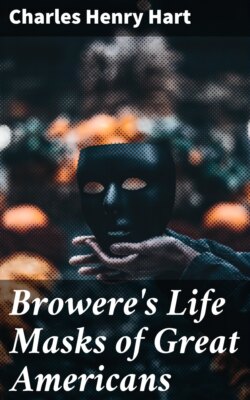Читать книгу Browere's Life Masks of Great Americans - Charles Henry Hart - Страница 7
На сайте Литреса книга снята с продажи.
III John Henri Isaac Browere
ОглавлениеTable of Contents
HAT one generation fails to appreciate, and therefore decries and sneers at, a subsequent one comprehends and applauds. It is conspicuously so in discovery, in science, in poetry, and in art; so much depends upon the point of view and the environment of the observed and of the observer. Were these remarks not true, the very remarkable collection of busts from life masks, taken at the beginning of the second quarter of the present century, by John Henri Isaac Browere, almost an unknown name a year ago, would not have been hidden away until their recent unearthing. The circumstances that led to their discovery are as curious as that the busts should have been neglected and forgotten for so long.
John Henri Isaac Browere, the son of Jacob Browere and Ann Catharine Gendon, was born at No. 55, Warren Street,
JOHN HENRI ISAAC BROWERE
New York city, November 18, 1792, and died at his house opposite the old mile-stone, in the Bowery, in the city of his birth, September 10, 1834, and was buried in the Carmine Street Churchyard. He was of Dutch descent, one of those innumerable claimants of heirship to Anneke Jans, through Adam Brouwer, of Ceulen, who came to this country and settled on Long Island, in 1642. Adam Brouwer’s name was really Berkhoven, but the name of his business, Brouwer or Brewer, became attached to him, so that his descendants have been transmitted by his trade-name, and thus, as is often the case, a new surname introduced. His second son, Jacob Adam Brouwer, or Jacob son of Adam the Brewer, married Annetje Bogardus, granddaughter of Reverend Edward Bogardus and Anneke Jansen (corrupted to Jans); and among the most persistent pursuers of the intangible fortune of Anneke Jans has been the family of Browere.
John Browere was entered as a student at Columbia College, but did not remain to be graduated, owing doubtless to his early marriage, on April 30, 1811, to Eliza Derrick, of London, England. He turned his attention to art and became a pupil of Archibald Robertson, the miniature-painter, who came to this country from Scotland, in 1791, with a commission from David Stuart, Earl of Buchan, to paint, for his gallery at Aberdeen, a portrait of Washington. Later on, Archibald Robertson, with his brother Alexander, opened at No. 79, Liberty Street, New York, the well-known Columbian Academy, where, for thirty years, these Scotchmen maintained a school, for the instruction of both sexes in drawing and in painting, and where Vanderlyn, Inman, Cummings, and other of the early New York artists, profited by their training. At the present time, when miniature-painting is again coming into vogue, it is interesting to reflect that the letters which passed between Archibald Robertson in this country, and his brother Andrew in Scotland, form the best treatise that can be found upon the charming art of painting in little. These letters, after having remained in manuscript for the better part of a century, have recently been given to the public, in a charming volume of “Letters and Papers of Andrew Robertson,” edited by his daughter, Miss Emily Robertson, of Lansdowne Terrace, Hampton Wick, England.
Determined to improve himself still further, Browere accepted the offer of his brother, who was captain of a trading-vessel to Italy, to accompany him abroad; and for nearly two years the young man travelled on foot through Italy, Austria, Greece, Switzerland, France, and England, diligently studying art and more especially sculpture. Returning to New York, he began modelling, and soon produced a bust of Alexander Hamilton, from Archibald Robertson’s well-known miniature of the Federal martyr, which was pronounced a meritorious attempt to produce a model in the round from a flat surface. Being of an inventive turn, he began experimenting to obtain casts from the living face in a manner and with a composition different from those commonly employed by sculptors. After many trials and failures, he perfected his process, with the superior results shown in his work.
Browere’s first satisfactory achievement was a mask of his friend and preceptor, Robertson, and his second was that of Judge Pierrepont Edwards, of Connecticut. But the most important of his very early works was the mask of John Paulding, the first to die of the captors of André; and this mask, made in 1817, was followed later by masks of Paulding’s coadjutors, Williams and Van Wart; so that we owe to Browere’s nimble fingers the only authentic likenesses we have of these conspicuous patriots of the Revolution.
Browere wrote verse and painted pictures in addition to his modelling, and, in the spring of 1821, made an exhibition at the old gallery of the American Academy of the Fine Arts, in Chambers Street, New York, which called forth the following card from his early instructor, Robertson, who was one of the directors of the Academy. It is interesting, notwithstanding the unconscious partiality one is apt to have for a former pupil, and is addressed:
